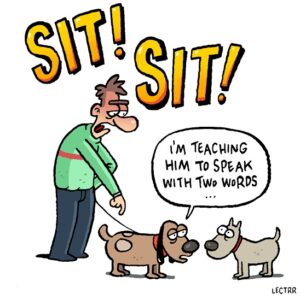Dog-walking should be required training for civil service diplomats. This is not to insult diplomats. It’s just that nothing tests a person’s people skills to the limit more than full immersion in the art of being pulled along a pavement by a mutt intent on publicly licking the arse of a stranger’s pet without being properly introduced.
Of course, dogs do many things in public that defy diplomacy and decorum, and we humans would all do the same if we hadn’t been burdened by the gift of embarrassment. But the fact is that we have been so burdened, and we naturally seek to impose embarrassment upon our dogs totally without success.
So they unwittingly rebel by randomly squatting in the path of the nearest passer-by. Or stop for a thoroughly good shake halfway across a pedestrian (and canine) crossing. Or thread themselves through a garden fence and double-back via a gorse bush so that it takes ten minutes to un-knot the lead.
None of this matters too much in the countryside where there are fewer people to meet and where you’re just as likely to find a farmer having a widdle against a tree as a dog. But at least the human widdler faces the tree and doesn’t stick a leg in the air, while the human observer steers him or herself away from the area, pretending to have seen nothing, rather than rushing dog-like to sniff the farmer’s bottom.
It’s what we call discretion. But dogs are no more burdened by discretion than they are by embarrassment.
That’s why, when dogs see another dog having a pee, they join in. It’s what we call pee-er group pressure. It’s in their DNA.
In town, these problems loom much larger of course. Navigating the streets, watching out for cyclists and scooterists and constantly having to anticipate the moment when your beloved pet will adopt the poo position in front of a supermarket are all routine skills that are quickly instinctive.
More challenging still is the direct engagement with fellow dog-walkers. This is where diplomacy is vital: some dog-walkers don’t want to meet others, either because their dog behaves badly, or they think the other person’s dog will behave badly. Or because they are just grumpy souls.
Some of these types will change course to avoid potential confrontation and good luck to them. Sometimes I’ll also change the route to keep clear of a massive rottweiler with drizzly jaws.
But when most of us are about to come face to face with a fellow dog-walker, we keep going because we have already sized up the walker, the dog and the intent, and made a judgement. You have to check not just body language, but doggy body language.
From a block away, the walker’s gait reveals a lot, as does the facial expression. A calm stride, a relaxed hold on the lead and the beginnings of a smile suggests an interest in stopping to exchange personal details such as sex, age and castration.
If that goes well, you can then move on to chatting about your respective dogs as they wag their tails and inspect each other’s orifices.
This is where the diplomacy comes in: “Hi there, that’s an impressive/magnificent/cute dog you’ve got, hope he’s not hungry hahaha, my dog would barely make a light snack for a brute like that!”
Or something like: “Wow! What a wonderful woolly jacket your dog’s wearing!? Did you knit it yourself? I might have to get one for my dog!”
Then comes an exchange of guess-the-breed, which rarely goes smoothly. A wrong assessment of a dog’s heritage can launch a whole debate about the origin of the species.
My own dog’s origins are vague: Sicilian street dog, elements of Cirneco dell’Etna (Google it: looks scary) but with softer, friendlier facial features and big floppy ears.
He wouldn’t wilfully harm a fly, but he would sniff and lick it to death, and he also barks very loudly at anything that looks remotely like a wolf.
That includes a huge but totally benign white beast, which I would categorise as a hairy, vulpine Labrador. His owner and I often stop for a chat, but it’s a fraught affair, conducted at shouting distance to avoid the dogs getting too close for comfort.
And when dogs do get too close for comfort, even friendly ones, it often ends with sniffed bottoms, entwined leads, and owners bent double, as they try to entangle the pets without accidentally engaging in intimate physical contact.
Ultimately, we dog walkers are at the beck and call of our pets. But that’s not how it should be. Right now, a group of us are fighting a cloak and dagger battle with unseen forces to safeguard a rather nice park where our doggy chums can run free, unleashed. Lately, someone, some authority, has planted signs indicating that dogs must be kept on leads.
All of us are rebelling. One of us, and it’s not me, has started taking the signs now and placing them, carefully, face-down in the park. But every couple of days, they mysteriously are back in place.
So for the moment, the dogs run free, as free as the wind blows, chasing sticks and barking up the wrong trees, while one of us keeps an eye out for the dog squad.
For the moment, there is a paws, but a reckoning is coming. And when it does, diplomacy, of the highest calibre, will be required.


